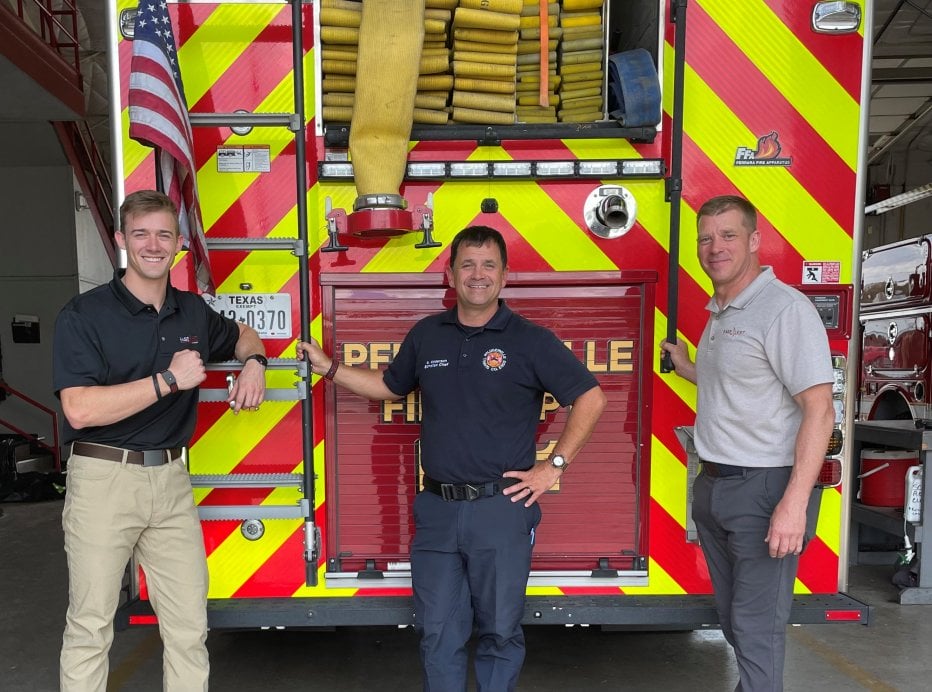Revolutionary Alerting Technology: Say ‘goodbye’ to flash-bang alerts in the middle of the night

By: Blake Richardson Cofounder & CEO
Ramp-up audible alarms and station automations have been among the top technologies to pave the way for emergency response innovation in the 21st century.
This innovative technology has helped to make alarm response more efficient than it had ever been before. The next generation of technology to improve alarm response is here: a tactile Firefighter Alerting System (FFAS) called EaseAlert.
Research has proven current alerting systems increase the risk of dying from a heart attack by as much as 1410%.1 Most dangers of firefighting are part of the job, but the alerting system should not be one of those dangers.
It turns out that those audible alarms in the middle of the night don’t just build character – they may also build your risk of cardiovascular disease. The research is clear: jarring, audible alarms cause physical and mental harm to firefighters. Remember the last time you got toned out in the middle of the night to respond to someone else’s emergency? Maybe it was last night.
If your firehouse is anything like most, you probably woke up to the tones at full blast as the bunk room lights automatically kicked on. You tried to gain your bearings as you geared up and listened for the dispatcher’s muffled voice. The disorientation from the tones might have been enough to confuse you as to where you were – let alone where you were going.
EaseAlert is solely focused on making that process less stressful and more efficient.

EaseAlert’s Firefighter Alerting System (FFAS) delivers vibration alerts via purpose-built wearables and low-impact red lights via bedside devices called BunkAlerts. The wearables are durable, heat-resistant, and water-resistant wristbands with a powerful battery. BunkAlerts simply plug into a wall outlet, providing red LEDs plus optional attachments including bed shakers and LED light strips.
Imagine waking up to a gentle, tactile vibration on your wrist and soft red LEDs next to your bunk. A few seconds later, you get toned out and the dispatcher follows up with details of the call. That’s what EaseAlert’s FFAS offers.
This job is not for the faint of heart – that’s no secret. The adrenaline rush that comes with it is often accompanied by significant physical exertion, and the mental strain of firefighting can be just as challenging. With the high rate of stress-related deaths and the ever-increasing demands on the fire service, this technology is exactly what the fire service needs. ‘That’s the way we’ve always done it,’ isn’t a reason to keep doing it.
EaseAlert has delivered more than 47,000 alerts to emergency responders throughout the United States. Pre- and post-surveys distributed to all emergency responders using EaseAlert showed that EaseAlert is 44% less physically startling and 50% healthier than their audible alerting systems. Responders also reported that they can understand dispatch information 24% more clearly with EaseAlert than they can with their audible alerting systems.
What firefighters have to say about EaseAlert:
“It helps me to not sleep through a call after a long day. It wakes me up much softer than the tones do. I definitely prefer having EaseAlert.”
– Lieutenant, Northeast Florida
“Allows me to do maintenance work where I am unable to hear the radio and not have to worry about missing a call.”
– FF/Paramedic, Northeast Florida
“Less of a strain on my cardiovascular health when we get calls in the middle of the night. Also provides a good couple second head start during the day.”
– Engineer, West Florida

The science behind the Technology
The science behind EaseAlert is based on research that shows that 1) noise can be a causative factor in stress-related illnesses, 2) tactile alerts are more effective than audible alerts, and 3) red lights reduce confusion when awoken. 2, 3, 4 To better understand the impact of this FFAS, EaseAlert partnered with leading researchers in the fire service to conduct the first-ever clinical study on tactile and visual alerting in the fire service.
The research team is led by Dr. Joel Billings, Dr. Keith Haddock, Dr. Sara Jahnke, and Dr. Carlos Poston, from the Center for Fire Rescue & EMS Health Research (CFREHR), Embry-Riddle Aeronautical University (ERAU), and National Developmental Research Institute (NDRI-USA). The study is being conducted in collaboration with Lee’s Summit Fire Department (Missouri) and Stillwater Fire Department (Oklahoma). Funding comes from the National Institutes of Health / National Heart, Lung, and Blood Institute (NIH/NHLBI).
The leadership team at EaseAlert is committed to working directly with firefighters and researchers to ensure this system is a true solution to a real problem.
“It’s an honor to work with cutting-edge researchers who understand the fire service and fire service professionals who embrace innovation. We’re confident that this study will confirm the need for an FFAS like EaseAlert’s,”
– Blake Richardson Co-founder and CEO, EaseAlert
The idea for EaseAlert came from a personal experience. One of the company’s co-founders, whose dad has been a firefighter for the past 19 years, saw the toll that firefighting was taking on his dad. He wanted to create a technology that could help reduce the strain of the alerting process while improving the efficiency of alarm response, and thus, EaseAlert was born.
EaseAlert is an innovative alerting solution that has the potential to revolutionize alarm response in the fire service. If you are interested in learning more about EaseAlert and the clinical study, visit www.easealert.com or email [email protected].
References
- Kales, S., et al. (2007). Heart disease deaths among firefighters. New England Journal of Medicine, 356(24), 2535–2537. https://doi.org/10.1056/nejmc071117
- Munzel, T., Gori, T., Babisch, W., & Basner, M. (2014). Cardiovascular effects of environmental noise exposure. European Heart Journal, 35(13), 829–836. https://doi.org/10.1093/eurheartj/ehu030
- Korres, G., Jensen, C. B. F., Park, W., Bartsch, C., & Eid, M. (2018). A Vibrotactile Alarm System for Pleasant Awakening. IEEE Transactions on Haptics, 11(3), 357 – 366. https://doi.org/10.1109/TOH.2018.2804952
- Figueiro, M. G., et al. (2019). Effects of Red Light on Sleep Inertia. Nature and Science of Sleep, Volume 11, 45–57. https://doi.org/10.2147/nss.s195563
Podcast
Contests & Promotions
















